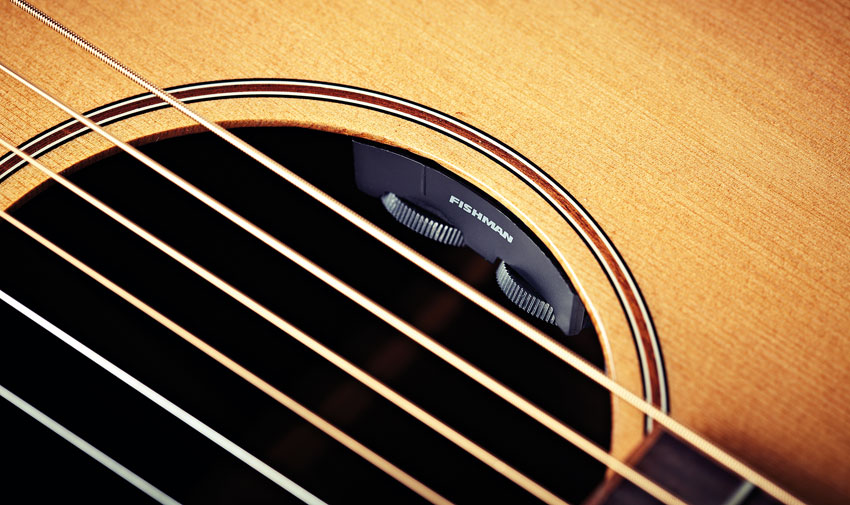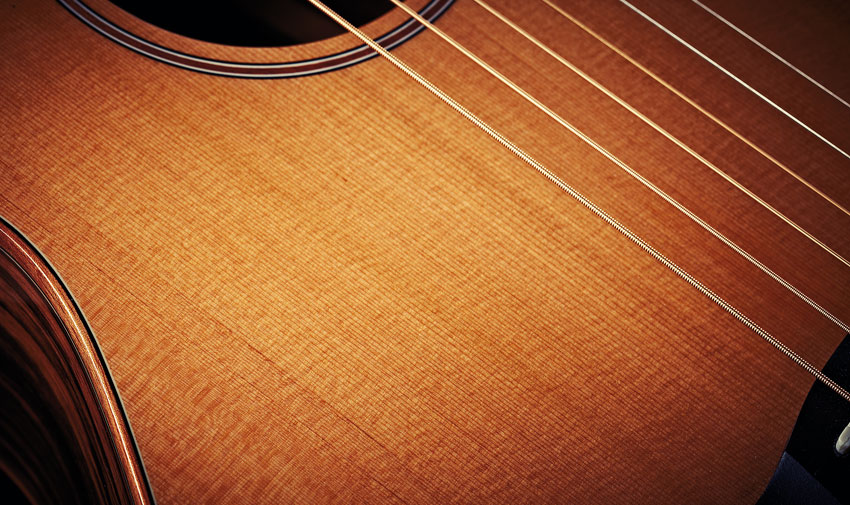MusicRadar Verdict
This little parlour may not offer the finest plugged-in experience we've ever had, but in every other respect - and at this price - just buy one.
Pros
- +
Great acoustic tones. Nice build and choice of materials. Price.
Cons
- -
Tuners. You'll want an outboard EQ if you're playing plugged-in.
MusicRadar's got your back

Tanglewood Java TWJP E review

Pickup

Body
Tanglewood's new Java series offers figured woods and impressive build quality at a surprising price point. We put the TWJP E electro acoustic through it's parlour-sized paces.
Reporting from the floor of Frankfurt Musikmesse earlier this year, we were overwhelmed by the number of lowly priced and very familiar-looking acoustics and electros on show. Doing something different in this cut-throat market sector is difficult, but Tanglewood has a talent for tempting us with low-price, attractive and engaging guitars. The instruments are all designed in the UK and made in Asia, with the exception of the Master Design models, which are conceived by Michael Sanden in Sweden.
"It's the striped, rosewood-like amara sides and back that are the real talking points"
This new Java mini-range is typical of Tanglewood and consists of four guitars: a parlour and folk in both acoustic and electro versions. Like many brands, Tanglewood has ukuleles within its range and the Java ukes come from a specific factory in Indonesia. So impressed was Tanglewood with the quality of the ukes, not to mention the wood choice, it commissioned these steel strings from the same facility. The result? Classy instruments whose prices belie their boutique looks.
The electro here is a highly competent build. The tan-coloured solid cedar top exhibits a close, precise grain with a thin rosette ring inlay and what appears to be mahogany binding (also featured on the fingerboard edges) with an inner purfling strip.
But it's the striped, rosewood-like amara sides and back that are the real talking points, with vibrant figuring and deep dark-to-milk chocolate colouration. The back has an insert of spalted mango with clean purfling inserts - there are even spruce strengthening strips inside the guitar along with clean spruce X-bracing and a traditionally kerfed lining.
The three-piece neck, which joins the body via a traditional dovetail is a big-ish rounded C. You can't expect a perfect fret job in this price range, and although it's tidy enough, there are some sharp-edged ends and slightly rough crowns that give a mildly scratchy tonality to bends. The downside of the relatively light mahogany fingerboard binding is that the small side dots lack contrast and make you think a little about your positioning, especially when switching between the 12-fret parlour and the 14-fret folk necks.
Bridge spacing is generous, however things are less spacious at the nut - it's not ideal, but it does give the guitar quite a mainstream do-it-all feel. You wouldn't expect a bone nut and saddle on a guitar at this price, and here it's classed as PPS (polyphenylene sulphide), a seemingly quite hard plastic that's very Tusq-like in appearance.
The guitar is very nicely finished, too. As you'd expect, the polyutherane is a bit over-egged and a little too shiny for our tastes. You can't help thinking that a Lowden-style 'posh' satin would really suit.
Feel and sounds
"Lows are tight and its highs are well rounded"
With a relatively trim depth, the guitar feels very comfortable played seated. Lows are tight and its highs are well rounded. If you're not used to a parlour's diminutive size, it takes some getting used to, but don't be surprised if you fall for its charms: a lovely at-home or travel guitar but with surprising projection that really should be auditioned for focused fingerpicking, not to mention more robust blues and slide licks. The lack of body bulk affects strumming styles, but if you have your flat pick (or thumbpick) and fingers technique down, you might find your soul mate.
Visuals aside, the back and sides seem to sit tonally between mahogany and rosewood 'norms'; there's warmth, but not at the expense of separation and clarity. The cedar top brings a sweetness and roundness to the high-end delivery that's ideal for older styles. It's one we'd recommend if you find the often brittle high-end zing of modern spruce-topped guitars a little ear-wearing, also if you have a light-to-medium picking/strumming style.
"Plugged in, things are equally healthy, although the tonality has too much midrange 'honk'"
Plugged in, things are equally healthy, although the tonality has too much midrange 'honk' when listening flat. Scooping out around 200Hz cures a feedback hotspot, but a more general midrange scoop produces a more usable and realistic sound.
The onboard tone control is of little help, simply offering some high-end reduction or enhancement. Either from an outboard preamp or amp/PA EQ, be prepared to tweak.
Still, it's important to put this side of the guitar into perspective. You might think buying the cheaper acoustic version and retrofitting your own pickup would be sensible: we were pondering just that until we realised something such as LR Baggs' Lyric bridgeplate microphone costs around two-thirds of the price of the guitar itself!
Can a sub-£400 electro really compete with a 'boutique' brand? No. But this Tanglewood puts on a good front with superb wood choices, competent build and lovely looks. It could do with some fingerboard and fret love, and we didn't find the nice-looking tuners that responsive, especially if you're changing tunings every other song, as many of us do. Also, the mid-heavy voice needs work with outboard EQ.
As a pure acoustic, however, it would be a great addition to your collection, would look very 'posh' on a stand in the living room and - more importantly - make a very useful, robust- sounding, good-looking practice, songwriting and recording tool.
Dave Burrluck is one of the world’s most experienced guitar journalists, who started writing back in the '80s for International Musician and Recording World, co-founded The Guitar Magazine and has been the Gear Reviews Editor of Guitarist magazine for the past two decades. Along the way, Dave has been the sole author of The PRS Guitar Book and The Player's Guide to Guitar Maintenance as well as contributing to numerous other books on the electric guitar. Dave is an active gigging and recording musician and still finds time to make, repair and mod guitars, not least for Guitarist’s The Mod Squad.
“I said, ‘Are we sure we can write a song about death?’”: The story of Mike + The Mechanics' classic No.1 The Living Years
“Without investment in music education our talent pipeline is at risk of drying up along with the huge opportunities for economic growth it brings”: UK Music draws up five point plan to “turbocharge” music education
“How daring to have a long intro before he’s even singing. It’s like psychedelic Mozart”: With The Rose Of Laura Nyro, Elton John and Brandi Carlile are paying tribute to both a 'forgotten' songwriter and the lost art of the long song intro










